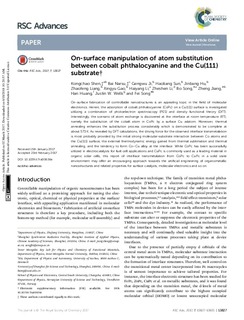| dc.contributor.author | Shen, Kongchao | |
| dc.contributor.author | Narsu, Bai | |
| dc.contributor.author | Ji, Gengwu | |
| dc.contributor.author | Sun, Haoliang | |
| dc.contributor.author | Hu, Jinbang | |
| dc.contributor.author | Liang, Zhaofeng | |
| dc.contributor.author | Gao, Xingyu | |
| dc.contributor.author | Li, Haiyang | |
| dc.contributor.author | Li, Zheshen | |
| dc.contributor.author | Song, Bo | |
| dc.contributor.author | Jiang, Zheng | |
| dc.contributor.author | Huang, Han | |
| dc.contributor.author | Wells, Justin | |
| dc.contributor.author | Song, Fei | |
| dc.date.accessioned | 2018-06-19T11:18:35Z | |
| dc.date.available | 2018-06-19T11:18:35Z | |
| dc.date.created | 2017-09-13T22:10:05Z | |
| dc.date.issued | 2017 | |
| dc.identifier.citation | RSC Advances. 2017, 7 (23), 13827-13835. | nb_NO |
| dc.identifier.issn | 2046-2069 | |
| dc.identifier.uri | http://hdl.handle.net/11250/2502092 | |
| dc.description.abstract | On-surface fabrication of controllable nanostructures is an appealing topic in the field of molecular electronics. Herein, the adsorption of cobalt phthalocyanine (CoPc) on a Cu(111) surface is investigated utilizing a combination of photoelectron spectroscopy (PES) and density functional theory (DFT). Interestingly, the scenario of atom exchange is discovered at the interface at room temperature (RT), namely the substitution of the cobalt atom in CoPc by a surface Cu adatom. Moreover, thermal annealing enhances the substitution process considerably which is demonstrated to be complete at about 573 K. As revealed by DFT calculations, the driving force for the observed interface transmetalation is most probably provided by the initial strong molecular-substrate interaction between Co atoms and the Cu(111) surface, the external thermodynamic energy gained from thermal sublimation and thermal annealing, and the tendency to form Co–Cu alloy at the interface. While CoPc has been successfully utilized in electrocatalysts for fuel cell applications and CuPc is commonly used as a leading material in organic solar cells, this report of interface transmetalation from CoPc to CuPc in a solid state environment may offer an encouraging approach towards the artificial engineering of organometallic nanostructures and related properties for surface catalysts, molecular electronics and so on. | nb_NO |
| dc.language.iso | eng | nb_NO |
| dc.publisher | The Royal Society of Chemistry | nb_NO |
| dc.rights | Navngivelse 4.0 Internasjonal | * |
| dc.rights.uri | http://creativecommons.org/licenses/by/4.0/deed.no | * |
| dc.title | On-surface manipulation of atom substitution between cobalt phthalocyanine and the Cu(111) substrate | nb_NO |
| dc.type | Journal article | nb_NO |
| dc.type | Peer reviewed | nb_NO |
| dc.description.version | publishedVersion | nb_NO |
| dc.source.pagenumber | 13827-13835 | nb_NO |
| dc.source.volume | 7 | nb_NO |
| dc.source.journal | RSC Advances | nb_NO |
| dc.source.issue | 23 | nb_NO |
| dc.identifier.doi | 10.1039/c7ra00636e | |
| dc.identifier.cristin | 1493535 | |
| dc.description.localcode | © The Royal Society of Chemistry 2017. This article is licensed under a Creative Commons Attribution 3.0 Unported Licence. | nb_NO |
| cristin.unitcode | 194,66,20,0 | |
| cristin.unitname | Institutt for fysikk | |
| cristin.ispublished | true | |
| cristin.fulltext | original | |
| cristin.qualitycode | 1 | |

